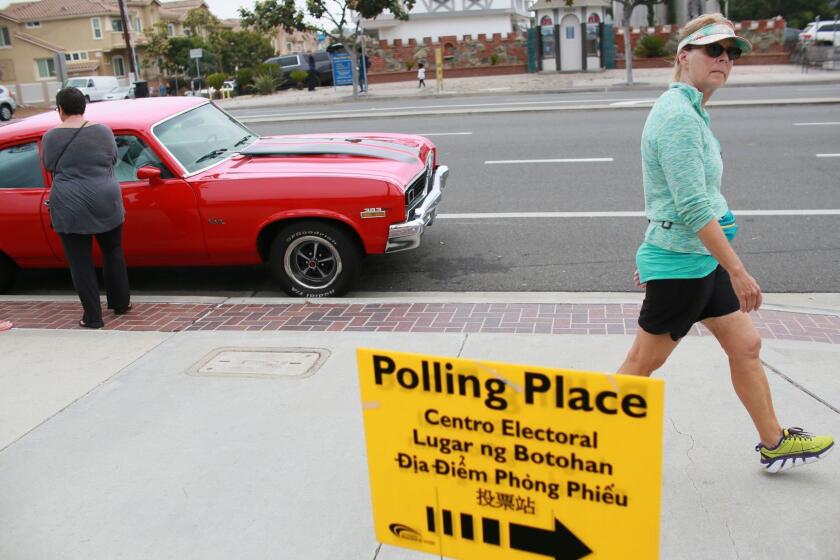Pedestrian deaths increased countywide
In November, two walkers were killed and another was injured after they were hit by cars around San Diego County. The accidents were certainly tragic, but they were also a part of an increase in pedestrian deaths in the county.
In 2014, 88 pedestrians were killed in motor vehicle accidents, the most since 1994 and up from 64 in 2013. This 35 percent rise is the biggest increase in causes of death evaluated by the San Diego County Medical Examiner last year.
Many of these walkers were intoxicated and on stretches of a road where they should not have been, Chief Deputy Medical Examiner Dr. Jonathan Lucas said. But exactly why this statistic went up is not known, he said.
“It’s not entirely clear if there’s a specific factor that we can tease out,” he said. “It’s not a number that’s uncharted territory compared to previous years, but it’s an uptick for sure.”
The county medical examiner released its annual report on Thursday, detailing the many ways that people die in the county, and the age, sex and race of the deceased. The medical examiner investigates deaths related to injuries, intoxication, violence, accidents, and deaths of a sudden and unexpected nature. Last year, that includes 2,972 people, with men outnumbering women by nearly a 2-to-1 ratio.
The difference between the sexes was due differences in the way men and women die, Lucas said.
“Men make up the bulk of our natural deaths, our accidental deaths, and even our suicides. They just tend to be more violent with that. It’s just a pattern we’ve seen for males,” Lucas said.
Thirty-four percent of deaths were due to natural causes like heart attack, cancer and other medical illnesses. Another 47 percent were classified as accidents. This includes drug overdoses, car crashes, and incidents at work and home. Suicides accounted for 14 percent, homicides for 3.3 percent, and another 1.4 percent were undetermined. The report said that these proportions were similar to previous years.
Amongst drug-related deaths, methamphetamines, a lab-made stimulant, was the biggest killer with 169 deaths, down from 190 the year prior. There was an increase in heroin-related deaths; in 2014 the drug killed 105 died last year, up from 89 in 2013.
Heroin-related deaths have become more common across the country, and the Centers for Disease Control and Prevention says it’s due to exposure and addiction to prescription opioids and a readily available supply of heroin.
“While the majority of prescription opioid users do not become heroin users, previous research found that approximately 3 out of 4 new heroin users report having abused prescription opioids prior to using heroin. This relationship between prescription opioid abuse and heroin is not surprising; heroin is an opioid, and both drugs act on the same receptors in the brain to produce similar effects. Heroin often costs less than prescription opioids and is increasingly available,” a 2012 report from the CDC says.
Alcohol, while certainly legal, caused 133 deaths, up slightly from the 127 the year prior. These deaths do not include drunk drivers who are killed in a car crashes or other mishaps that occur while under the influence. In accidental deaths involving any intoxicant, alcohol was the second-most common substance, after meth and before heroin. Prescription drugs were responsible in 246 deaths.
Motor vehicle related deaths increased from 247 to 291. In 34 cases a passenger was killed, and in 70 the driver died. Fifty-seven motorcyclists were killed, as were 10 people on bicycles.
There were 420 suicides, or 13.1 deaths for every 100,000, higher than state and national rates. It included 138 suicides by hanging, the most for any year since 1998. The worst year for suicides was 2013 when there were 441. Last year was the second-worst.
The report is intended to give the community a better way to understand why people die suddenly and to help lawmakers and leaders develop better policies and programs to keep people safe, Lucas said.
Or, as Chief Medical Examiner Dr. Glenn N. Wagner, said in the report loved ones and friends can still enrich communities even in death.
“The dead do have a story to tell – not only of death but of life – and we, the living, have an obligation to listen to that story and perhaps, just perhaps, learn something about ourselves and our community,” he wrote.


